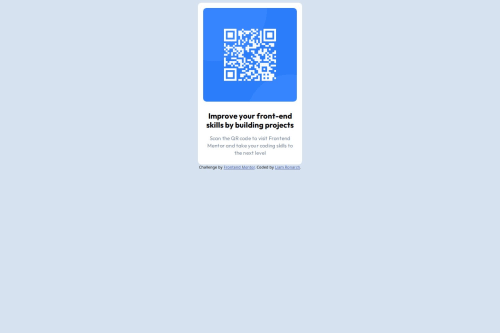QR Component Page using CSS Flex

Solution retrospective
I am proud that this did not take too long and my initial ideas of how to divide the project worked well. I would look at the style guide earlier than I did.
What specific areas of your project would you like help with?Centering the main part of the project. I already used display: flex, align-items:center, justify-content: center on the parent of the main container I used to hold the QR code, so I was unable to figure it out.
Please log in to post a comment
Log in with GitHubCommunity feedback
- @DylandeBruijn
@liamlizard
Hiya! 👋
Congratulations on your solution, it looks very close to the design! I can tell you put a lot of effort into it.
Things you could improve ✍️
-
I suggest adding a bit of
paddingto yourbodyelement so the card has some space around it on smaller viewports. -
You could add a
min-height: 100vhto yourbodyelement instead ofheight: 100vhso it takes up the full height of the viewport while still being able to grow when the content inside it grows. -
Try experimenting with CSS variables, they help you make your CSS values more reusable across your code.
-
Try using semantic HTML elements like
main,sectionandarticle. -
Try using using relative CSS units like
remandemthey make your layout more adaptable. -
You don't have to put
width: 100vwon yourhtmlandbody. These elements areblockelements and take up the full width of their parent by default. -
You don’t have to wrap your image in a separate
div, it’s possible to style it directly to achieve the same result. -
Instead of using the
belement, try using something like aptag and CSS to make your text bold.
I hope you find my feedback helpful! 🌟
Let me know if you have more questions and I'll do my best to answer them. 🙋♂️
Happy coding! 😎
-
- P@Hekimianz
If you put a height of 100vh on the body it should center it if you already put flex on it :D
Join our Discord community
Join thousands of Frontend Mentor community members taking the challenges, sharing resources, helping each other, and chatting about all things front-end!
Join our Discord